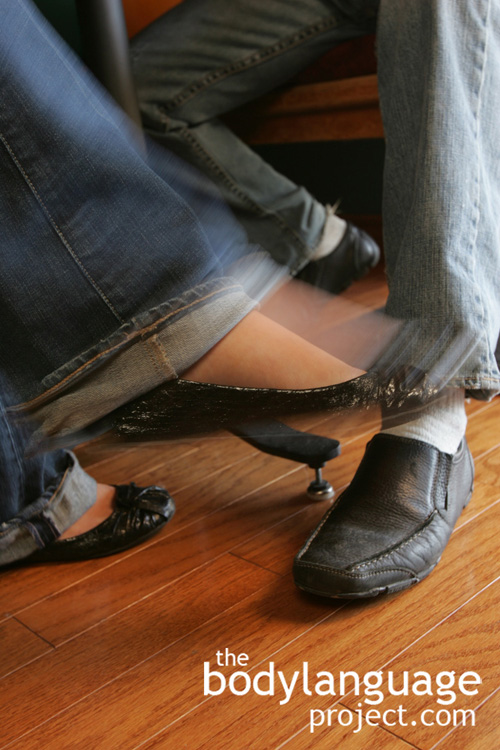Body Language of Foot Kicking
Synonym(s): Leg Kick Response, Kicking The Foot.
Description: Foot kicking is directed, forceful and more of a single motion, but it too can be repeated as in foot jiggling.
In One Sentence: Foot kicking is a signal that one is experiencing negative emotions.
How To Use it: Use a foot kicking motion to show others that you are in disagreement with them and their ideas. You can also jiggle feet to blow off extra energy.
Context: General.
Verbal Translation: “I’m experiencing negative thoughts and emotions and I’m showing what I’d like to do with those ideas – kick the crap out of them, that’s what.”
Variant: See Foot Fidgeting.
Cue In Action: Julie wasn’t happy when her friend Debbie received the award for best student. Her foot began an up and down kicking motion each time her name was mentioned in the speech. Her foot motion showed her negative thoughts.
Meaning and/or Motivation: Anytime foot jiggling suddenly turns to foot kicking while seated shows that a person has heard something negative and responding to the discomfort.
Jiggling usually depicts nervousness or boredom, but kicking on the other hand, is used to fight off unpleasant thoughts. This gesture is subconscious and visceral so is a reliable predictor because under most circumstances people don’t realize that they do it. Foot kicking can therefore tell you what people really think about what sort of questions you are asking them because once posed, they will readily begin to kick if it makes them uncomfortable. Foot kicking while seated shows that a person has heard something negative. It is a response to discomfort and is a direct consequence of the fight or flight response.
Cue Cluster: Foot kicking is associated with hand wringing, pinching of the skin, scratching the neck, hand clenching and gripping, balling of the fists, sucking or chewing on a pen and other aggressive body language.
Body Language Category: Aggressive body language, Anger, Dislike (nonverbal), Displacement behaviour, Energy Displacement, Frustration or frustrated body language, Hostile body language, Leaked or involuntary body language, Microgestures.
Resources:
Arsenio, W. F., Cooperman, S., & Lover, A. Affective Predictors of Preschooler’s Aggression and Peer Acceptance: Direct and Indirect Effects. Developmental Psychology. 2000. 36: 438-448.
Anderson, C. A., & Bushman, B. J. (2002). Human aggression. Annual Review of Psychology, 53, 27–51. http://dx.doi.org/10.1146/annurev.psych.53.100901. 135231.
Bjorkqvist, K., Osterrnan, K. and Lagerspetz, K.M.I. (1994) ‘Sex Differences in Covert Aggression among Adults’, Aggressive Behaviour 20: 27–33.
Freedman, Norbert ; Blass, Thomas ; Rifkin, Arthur ; Quitkin, Frederic Lanzetta, John T. (editor). Body movements and the verbal encoding of aggressive affect. Journal of Personality and Social Psychology. 1973. 26(1): 72-85.
Geniole, Shawn N. ; Mccormick, Cheryl M. Facing our ancestors: judgements of aggression are consistent and related to the facial width-to-height ratio in men irrespective of beards. Evolution and Human Behavior. 2014. 1090-5138.
Hubbard, J. A. Emotion expression processes in children’s peer interaction: The role of Peer Rejection, Aggression, and Gender. Child Development. 2001. 72: 1426-1438.
Hubbard, J. A., Smithmyer, C. M., Ramsden, S. R., Parker, E. H., Flanagan, K. D., Dearing, K. F., Relyea, N., & Simons, R. F. Observational, Physiological, and Self-Reported Measures of Children’s Anger: Relations to Reactive Versus Proactive
Aggression. Child Development. 2002. 73, 1101-1118.
Hines, N.J. and Fry, D.P. (1994) ‘Indirect Modes of Aggression among Women of Buenos Aires, Argentina’, Sex Roles 30: 213–24.
Johnson, Richard R. and Jasmine L. Aaron. Adults’ Beliefs Regarding Nonverbal Cues Predictive of Violence. Criminal Justice and Behavior. 2013. 40 (8): 881-894. DOI: 10.1177/0093854813475347.
http://bodylanguageproject.com/articles/wanna-fight-nonverbal-cues-believed-indicate-violence
Lagerspetz, K.M.J., Bjorkqvist, K. and Peltonen, T. (1988) ‘Is Indirect Aggression Typical of Females? Gender Differences in Aggressiveness in 11- to 12-year-old Children’, Aggressive Behavior 14: 403–14.
Navarro, Joe. 2008. What Every BODY is Saying: An Ex-FBI Agent’s Guide to Speed-Reading People. William Morrow Paperbacks.
Ostrowsky, Michael K. Are violent people more likely to have low self-esteem or high self-esteem? Aggression and Violent Behavior. 2010. 15(1): 69-75.
Pailing, Andrea ; Boon, Julian ; Egan, Vincent. Personality, the Dark Triad and violence Personality and Individual Differences. 2014. 67: 81-86.
Sporer, Siegfried L. ; Schwandt, Barbara Penrod, Steven D. (editor). MODERATORS OF NONVERBAL INDICATORS OF DECEPTION: A Meta-Analytic Synthesis.
Psychology. Public Policy, and Law. 2007. 13(1): 1-34.
Topel, Eva-Maria ; Lachmann, Frankm. Nonverbal Dialogues: Orienting and Looking Behaviors Between Aggressive and Violent Children and Adolescents and Their Therapist. Journal of Infant, Child, and Adolescent Psychotherapy. 2007. 6(4): 285-307.
Underwood, M. K.. Glares of Contempt, Eye Rolls of Disgust and Turning Away to Exclude: Non-Verbal Forms of Social Aggression among Girls. Feminism & Psychology. 2004 14(3): 371-375.

